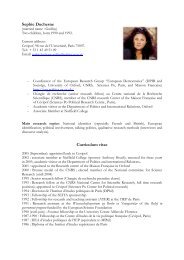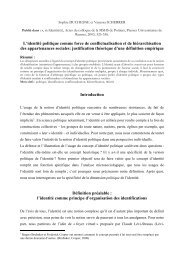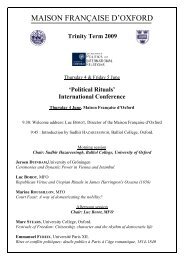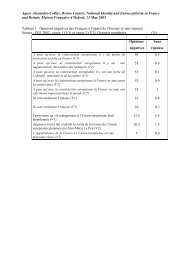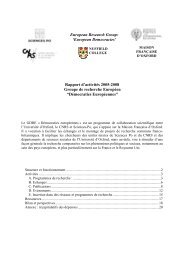Examining Caste and Religion in Post-Industrial Mumbai - OxPO ...
Examining Caste and Religion in Post-Industrial Mumbai - OxPO ...
Examining Caste and Religion in Post-Industrial Mumbai - OxPO ...
You also want an ePaper? Increase the reach of your titles
YUMPU automatically turns print PDFs into web optimized ePapers that Google loves.
<strong>Exam<strong>in</strong><strong>in</strong>g</strong> <strong>Caste</strong> <strong>and</strong> <strong>Religion</strong> <strong>in</strong> <strong>Post</strong>-<strong>Industrial</strong> <strong>Mumbai</strong><br />
A Case Study of <strong>Mumbai</strong>’s Ex-Millworkers Occupational Choices<br />
Jo<strong>in</strong>t Doctoral Sem<strong>in</strong>ar 2011, Sciences Po<br />
The Dynamics of Politics <strong>and</strong> Inequalities<br />
25-26 May 2011<br />
Sumeet Mhaskar<br />
Doctoral C<strong>and</strong>idate <strong>in</strong> Sociology<br />
St. Antony’s College & Department of Sociology<br />
University of Oxford
Overview<br />
Questions<br />
Data <strong>and</strong> Methods<br />
Towards a <strong>Post</strong>-<strong>Industrial</strong> <strong>Mumbai</strong><br />
<strong>Caste</strong>, <strong>Religion</strong> <strong>and</strong> Occupation <strong>in</strong> <strong>Industrial</strong> <strong>Mumbai</strong>: Textile Mills,<br />
Parallel Work <strong>and</strong> 1982 <strong>Mumbai</strong> Textile Strike<br />
<strong>Caste</strong>, <strong>Religion</strong> <strong>and</strong> Occupation <strong>in</strong> <strong>Post</strong>-<strong>Industrial</strong> <strong>Mumbai</strong>: Employment<br />
<strong>and</strong> Small Bus<strong>in</strong>esses.<br />
Conclusion
Questions<br />
Are social <strong>in</strong>stitutions, such as caste <strong>and</strong><br />
religion, affect<strong>in</strong>g (or not) ex-millworkers’<br />
occupational choices?<br />
What is happen<strong>in</strong>g to caste <strong>and</strong> religion as<br />
social <strong>in</strong>stitutions <strong>and</strong> how far are exist<strong>in</strong>g<br />
<strong>in</strong>equalities <strong>and</strong> hierarchies buttressed?
Survey Data<br />
<strong>Caste</strong> Groups Freq % Freq %<br />
High <strong>Caste</strong> H<strong>in</strong>dus 441 43 386 42<br />
H<strong>in</strong>du Other<br />
Backward <strong>Caste</strong>s<br />
Data <strong>and</strong> Methods<br />
<strong>Mumbai</strong>’s Ex-Millworkers’ who lost their jobs s<strong>in</strong>ce late 1990s.<br />
Interviews: Snowball Sampl<strong>in</strong>g<br />
Survey Data : From Quota Sampl<strong>in</strong>g to Opportunistic Method.<br />
399 38 357 39<br />
Dalits 107 10 94 10<br />
Muslims 37 04 36 04<br />
Miscellaneous 53 05 51 06<br />
Total 1037 100 924 100<br />
Interviews<br />
<strong>Caste</strong> Groups Freq %<br />
High <strong>Caste</strong> H<strong>in</strong>dus 19 24<br />
H<strong>in</strong>du OBC 03 04<br />
Dalits 28 35<br />
High <strong>Caste</strong> Muslims 24 30<br />
Muslim OBC 04 05<br />
Nomadic Tribes 02 03<br />
Total 80 100
<strong>Mumbai</strong>: Towards a <strong>Post</strong>-<strong>Industrial</strong> City<br />
Textile Mills Closure <strong>in</strong> Girangaon<br />
58 Textile Mills employ<strong>in</strong>g around 250,000 <strong>in</strong> early 1980s <strong>and</strong><br />
150,000 by early 1990s<br />
Allied Industries depend<strong>in</strong>g on textile <strong>in</strong>dustry.<br />
Share of organized/formal sector employment has reduced from<br />
65% <strong>in</strong> 1961 to 35% <strong>in</strong> 1991<br />
<strong>Post</strong>- <strong>Industrial</strong> Economy<br />
Bank<strong>in</strong>g, Insurance, Information Technology Enabled<br />
Shopp<strong>in</strong>g Malls, Enterta<strong>in</strong>ment Industry<br />
Increase <strong>in</strong> the service sector employment from 303, 557 <strong>in</strong> 1980<br />
to 753, 624 <strong>in</strong> 1998
<strong>Caste</strong> & Occupation: The Debate<br />
<strong>Caste</strong> (or jatis) <strong>and</strong> its association with occupations <strong>and</strong><br />
status<br />
Occupations ascribed by birth<br />
Restrictions on occupational mobility<br />
Modernization Thesis: Weaken<strong>in</strong>g of community identities<br />
<strong>in</strong> urban <strong>in</strong>dustrial context (e.g. Sr<strong>in</strong>ivas 1969).<br />
<strong>Caste</strong>, religion <strong>and</strong> gender determ<strong>in</strong>ed what work<br />
<strong>in</strong>dividuals did <strong>in</strong> the textile mills (Ch<strong>and</strong>avarkar 1994).<br />
Exclusion of Dalits (ex-untouchables) from Weav<strong>in</strong>g Sheds<br />
Muslims as ‘neo-untouchables’ (Hansen 2001).
Parallel Work<br />
100/1037 (nearly10 per cent) engaged <strong>in</strong> Parallel Work<br />
Straddled formal as well <strong>in</strong>formal economy.<br />
Supplement<strong>in</strong>g Income<br />
15 % Engaged <strong>in</strong> <strong>Caste</strong> Based Work<br />
Charmakars (Leather Workers), Sutar (Carpenter), Nhavi<br />
(Barber)<br />
85 % Non-<strong>Caste</strong> Occupations<br />
High castes <strong>in</strong> clean<strong>in</strong>g <strong>and</strong> manual occupations.<br />
Fast Food: Absence of Dalits <strong>and</strong> Muslims.
1982 Strike Work<br />
18 Months strike <strong>in</strong>volv<strong>in</strong>g 250,000 workers<br />
<br />
<br />
608/1037, nearly 60 per cent <strong>in</strong> our survey were affected by the<br />
strike.<br />
405/608, around 67 per cent, did some work while the rest did not<br />
take up any work dur<strong>in</strong>g the 18 months strike.<br />
Only 2% <strong>in</strong> caste based work<br />
<br />
Rest<br />
<br />
<br />
<br />
<br />
Barber, Carpenter, Goldsmiths, Leather Work<br />
24 % Farm<strong>in</strong>g<br />
Aga<strong>in</strong>, Dalit <strong>and</strong> Muslims absent from the fast food<br />
Only Dalits <strong>and</strong> Muslims engaged <strong>in</strong> Scrap Metal Collection<br />
Wage Labour relation weak & Small Bus<strong>in</strong>esses still relevant
<strong>Caste</strong>, <strong>Religion</strong> & Occupation <strong>in</strong> <strong>Post</strong>-<strong>Industrial</strong> <strong>Mumbai</strong><br />
More than 60 per cent are engaged <strong>in</strong> some k<strong>in</strong>d of job<br />
after the closure of mills.<br />
70 % <strong>in</strong> Wage Labour<br />
<br />
<br />
40 % <strong>in</strong> Security, Courier & Shops.<br />
With<strong>in</strong> each group: 46 % High <strong>Caste</strong> H<strong>in</strong>dus; 39 % OBC H<strong>in</strong>dus,<br />
46 % Dalits <strong>and</strong> 16 % Muslims<br />
30 % Small Bus<strong>in</strong>esses<br />
<br />
<br />
Only 3 per cent <strong>in</strong> <strong>Caste</strong> based Occupations. Footwear Stitch<strong>in</strong>g<br />
& Sell<strong>in</strong>g, Religious Preacher, Goldsmiths, Carpenter, Barber,<br />
Laundry, Weav<strong>in</strong>g & Fish<strong>in</strong>g<br />
Absence of Dalits <strong>and</strong> Muslims Fast Food.
Conclusion<br />
Very few ex-millworkers engaged <strong>in</strong> their caste based occupations.<br />
Wage Labour shows weak trend <strong>in</strong> terms of the <strong>in</strong>fluence of caste on<br />
occupation but does show some trend for the less participation of<br />
Muslims.<br />
Self –Employment/Small Bus<strong>in</strong>esses is where some caste cluster<strong>in</strong>g is<br />
seen. Esp. the absence of Dalits <strong>and</strong> Muslim from Fast Food <strong>and</strong> only<br />
their engagement <strong>in</strong> Scrap Metal Collection.<br />
New hierarchies are created by mak<strong>in</strong>g Muslims are neo-untouchables.
Comments <strong>and</strong> Suggestions<br />
Thank You



